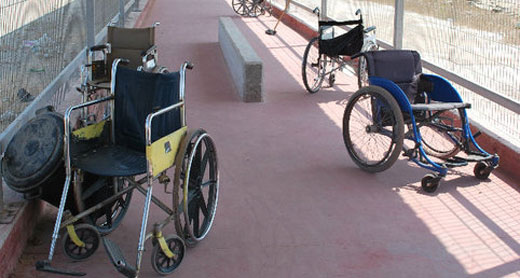Jasbir Puar’s argument in The Right to Maim of Israel’s deliberate debilitation of Palestinians—by bodily and psychological injury, social exclusion, economic stunting, and political encumberance—is a poignant one. Indeed, one simply has to turn on the news to see tens of thousands of Palestinians rendered “disabled”: limbless, blind, weakened, orphaned, psychologically scarred, through a combination of military violence, border controls, import limitations, infrastructural restrictions and de-development, political silencing. Such debilitation, as Puar demonstrates, has become endemic: “a banal feature of quotidian existence that is already definitive in the precarity of that existence” (16); a practice that bespeaks a horrendous extreme of the possibilities of biopolitical metrics.
More than simply the maiming of bodies or infrastructure, debilitation is enacted on Palestinian mobility and spatiality, on generational and temporal levels. The goal—if not at least the outcome—is to “preemptively debilitate the resistant capacities of another intifada, the next intifada” (16). The target of Israel’s control is not Palestinian life itself but resistance.
But the implications go further. First, maiming and debilitation do not only occur during moments of heightened violence. The “history” of maiming is not new to the 2014 war on Gaza, nor the 1987 intifada, but has been an ongoing century-long process—from the Balfour Declaration first setting it in motion to present conditions. The Palestinian struggle is very much the unfinished business of imperialism and continues to be defined by a settler-colonial framework.
As Palestinians, we are born with “birth defects,” suffering from pre-existing conditions: we have no state, we are immediately labeled terrorists, we belong to a past of “national liberation” that is (or seems) largely outmoded today; we are marginalized, de-normalized; in short, debilitated.
We have been, and remain, continuously out of sync with the world. Thus, second, Puar’s argument points to something much more profound and troubling: the right to maim is enacted on the politics of future possibility, which is a foreclosed future. The Right To Maim has everything to do with the question of temporality. What kind of future becomes possible given the maiming of bodies and infrastructure, the maiming of possible (future) resistance? Such maiming is, as she argues, determinative: it closes off agency and possibility.
One can take Gaza as the prime example—but importantly, not a unique one in the context of Israel/Palestine. Gaza has been created and is sustained as a “natural” disaster likely to happen, always on the edge of collapse, a collapse that is always rendered even more perverse, more apocalyptic every year–but yet one which is continuously seen as not happened yet. Gaza is an uninhabitable place whose population only increases under worse and worse conditions. In Puar’s words, “the terms of futurity are already dictated in the present but also the terms of the present are dictated through the containment of the terms of the future, in an effort to keep the present in line with one version of the future that is desired” (148). That future is bleak: Palestinians are prisoners.
Imprisonment, here, is an obvious form of punishment: it exists purely as a sentence, a punishment. And imprisonment equally demonstrates the temporal predicament at the heart of the Palestinian condition, which Puar’s argument of maiming and debilitating gets at. Incarceration demonstrates the unevenness of temporalities, how control over time leaves individuals more vulnerable to control, and how the inability to control time prevents its organization and undermines an individual’s and society’s sense of being. It is temporal nothingness.
This kind of future is precisely what Palestinians face–at checkpoints, in camps, behind walls; with the continuous “postponement” of a political solution; with the now decades-long “temporary occupation” of their land. Imprisonment is both metaphorical and literal here. 70% of Palestinian families have had one or more family members jailed in Israeli prisons since 1967; somewhere between 40% and 50% of the male population has been in prison at some point of their lives. Imprisonment occurs mostly as a result of activities resisting the occupation.
But even in prison, where the future is already foretold and time is already dead, the Israeli regime exacts further control. Over the past few decades, Palestinian prisoners have been holding mass hunger strikes, protesting the practice of administrative detention without the right to trial. And every time, Israel raises the threat of forced drip-feeding, so as to prevent the prisoners from dying. Even as prisoners, Palestinians must remain, in “maimed time,” always already dying. This is the future being produced on a societal level through debilitation: Palestinians must remain, in perpetual temporariness, in order to live through their annihilation.


